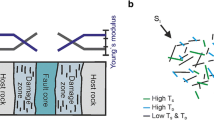Abstract
Reservoir compartments, typical targets for infill well locations, are commonly created by faults that may reduce permeability. A narrow fault may consist of a complex assemblage of deformation elements that result in spatially variable and anisotropic permeabilities. We report on the permeability structure of a km-scale fault sampled through drilling a faulted siliciclastic aquifer in central Texas. Probe and whole-core permeabilities, serial CAT scans, and textural and structural data from the selected core samples are used to understand permeability structure of fault zones and develop predictive models of fault zone permeability. Using numerical flow simulation, it is possible to predict permeability anisotropy associated with faults and evaluate the effect of individual deformation elements in the overall permeability tensor. We found relationships between the permeability of the host rock and those of the highly deformed (HD) fault-elements according to the fault throw. The lateral continuity and predictable permeability of the HD fault elements enhance capability for estimating the effects of subseismic faulting on fluid flow in low-shale reservoirs.












Similar content being viewed by others
References
Antonellini, M., & Aydin, A. (1994). Effect of faulting on fluid flow in porous sandstones: Petrophysical properties. AAPG Bulletin, 78(3), 355–377.
Bouvier, J., Kaars-Sijpesteijn, C., Kluesner, D., Onyejekwe, C., & Van Der Pal, R. (1989). Three-dimensional seismic interpretation and fault sealing investigations, Nun River field, Nigeria. AAPG Bulletin, 73(11), 1397–1414.
Childs, C., Walsh, J., & Watterson, J. (1997). Complexity in fault zone structure and implications for fault seal prediction. In P. Moller-Pedersen & A. Koestle (Eds.), Hydrocarbon seals: Importance for exploration and production (pp. 61–72). Norwegian Petroleum Society (NPF) Special Publication No 7, Elsevier, Singapore.
Deutsch, C. V. (2002). Geostatistical reservoir modeling. Oxford: Oxford University Press.
Flodin, E. A., Aydin, A., Durlofsky, L. J., & Yeten, B. (2001). Representation of fault zone permeability in reservoir flow models. In Society of Petroleum Engineers Annual Technical Conference and Exhibition, SPE paper 71617, New Orleans, LA.
Hardy, G. H., Littlewood, J. E., & Polya, G. (1934). Inequalities. Cambridge: Cambridge University Press.
Hesthammer, J., Johansen, T. E. S., & Watts, L. (2000). Spatial relationships within fault damage zones in sandstone. Marine and Petroleum Geology, 17(8), 873–893.
Ibañez, W. D. (2000). Characterization of the structure and permeability of shear zones in a siliciclastic aquifer. Ph.D. Dissertation, Texas A&M University, College Station, TX.
Jensen, J. L., Lake, L. W., Corbett, P. W. M., & Goggin, D. J. (2000). Statistics for petroleum engineers and geoscientists (2nd ed.). Amsterdam: Elsevier.
Jev, B., Kaars-Sijpesteijn, C., Peters, M., Watts, N., & Wilkie, J. (1993). Akaso Field, Nigeria: Use of intergrated 3-D seismic, fault slicing, clay smearing and RFT pressure data on fault trapping and dynamic leakage. AAPG Bulletin, 77(8), 1389–1404.
Jones, S. C. (1994). A new, fast, accurate pressure-decay probe permeameter. SPE Formation Evaluation, 9(3), 193–199.
Jourde, H., Flodin, E. A., Aydin, A., Durlofsky, L. J., & Wen, X. (2002). Computing permeability of fault zones in eolian sandstone from outcrop measurements. AAPG Bulletin, 86(7), 1187–1200.
Kendall, M., & Stuart, A. (1977). The advanced theory of statistics, Vol. I: Distribution theory. New York: MacMillan.
Knipe, R. J. (1998). Fault systems and migration processes. AAPG Bulletin, 82(13), 786–798.
Knott, S. (1993). Fault seal analysis in the North Sea. AAPG Bulletin, 77(5), 778–792.
Lindsay, N., Murphy, F., Walsh, J., & Watterson, J. (1993). Outcrop studies of shale smears on fault surfaces. In S. S. Flint & I. D. Bryant (Eds.), The geological modeling of hydrocarbon reservoirs and outcrop analogues (pp. 113–126). Oxford: Blackwell Scientific.
Myers, R. (1999). Structure and hydraulics of brittle faults in sandstone. Ph.D. Dissertation, Stanford University, Palo Alto, CA.
Nieto, J. (2004). Permeability characterization of shear zones in the Hickory Sandstone member, Riley Formation, Texas. M.S. Thesis, Texas A&M University, College Station, TX.
Randolph, L. C. (1991). The effects of faults on the groundwater system in the Hickory sandstone aquifer in central Texas. M.S. Thesis, Texas A&M University, College Station, TX.
Rice, J. A. (1988). Mathematical statistics and data analysis. Pacific Grove, CA: Wadsworth and Brooks/Cole.
Robertson, E. (1983). Relationship of fault displacement to gouge breccia thickness. Mining Engineering, 35(10), 1426–1432.
Rollins, J., Holditch, S. H., & Lee, W. J. (1992). Characterizing average permeability in oil and gas formations. SPE Formation Evaluation, 7(2), 99–105.
Shengjie, Z. (1999). The experimental study on the influence of fault on hydrocarbon migration and entrapment. AAPG Bulletin, 83(11), 1881–1900.
Shipton, K., Evans, J. P., Robeson, K. R., Forster, C. B., & Snelgrove, S. (2002). Structural heterogeneity and permeability in faulted eolian sandstone: Implications for subsurface modeling of faults. AAPG Bulletin, 86(5), 863–883.
Wellington, S. L., & Vinegar, H. J. (1987). X-ray computerized tomography. Journal of Petroleum Technology, 39(9), 885–898.
Wilson, J. S. (2001). High-resolution stratigraphic and structural characterization of the fault-partitioned hickory sandstone aquifer, Mason county, central Texas. M.Sc. thesis, Texas A&M University, College Station, TX.
Yielding, G., Freeman, B., & Needham, D. (1997). Quantitative fault seal prediction. AAPG Bulletin, 81(6), 897–917.
Acknowledgments
The authors acknowledge the provision of the samples and the geological framework by the Industrial Associates Program at Texas A&M University used in this study. The authors thank Mr. F. M. Chester for his insights and discussions concerning this research work. The Petroleum Research Fund of the American Chemical Society and the BMFFFS project, directed by Heriot-Watt University, provided the partial financial support of this research study. J. Nieto thanks the GCAGS for a student grant. Jerry Jensen holds the Schulich Chair in Geostatistics.
Author information
Authors and Affiliations
Corresponding author
Rights and permissions
About this article
Cite this article
Nieto Camargo, J.E., Jensen, J.L. Analysis of Fault Permeability Using Mapping and Flow Modeling, Hickory Sandstone Aquifer, Central Texas. Nat Resour Res 21, 395–409 (2012). https://doi.org/10.1007/s11053-012-9181-5
Received:
Accepted:
Published:
Issue Date:
DOI: https://doi.org/10.1007/s11053-012-9181-5




